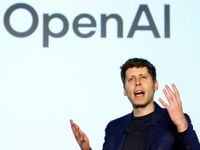OpenAI and Amazon have set the tech world abuzz with the announcement of a landmark $38 billion, seven-year partnership that will see the ChatGPT creator run its artificial intelligence workloads on Amazon Web Services (AWS) in the United States. The deal, unveiled on November 3, 2025, is being hailed as a major leap for both companies—and a clear signal of the intensifying race for dominance in the rapidly evolving AI industry.
Under the terms of the agreement, OpenAI will gain access to hundreds of thousands of Nvidia’s specialized AI chips—including the powerful GB200 and GB300 accelerators—deployed in Amazon’s state-of-the-art data centers. This computing firepower is essential for training and running the next generation of OpenAI’s models, powering everything from ChatGPT’s responses to ambitious, as-yet-unveiled AI breakthroughs.
Amazon’s stock responded with enthusiasm, soaring by more than 4% immediately after the announcement and hitting an all-time high. According to Reuters, the surge added nearly $140 billion to Amazon’s market value. The deal marks Amazon’s first major AI initiative since a company-wide restructuring announced just a week prior, which saw the e-commerce giant lay off 14,000 employees. Despite speculation, Amazon CEO Andy Jassy insisted during an earnings call that the layoffs were “not really financially driven, and it’s not even really AI-driven, not right now at least.”
For OpenAI, the partnership represents a decisive step away from its nonprofit roots and toward a more aggressive, capital-driven business model. Regulators in California and Delaware gave their blessing last week to OpenAI’s new corporate structure, which is specifically designed to attract investment and enable profit-making. This change also removed Microsoft’s first right of refusal to supply cloud services—a significant shift, given that Microsoft had been OpenAI’s exclusive cloud provider until early 2025.
“The rapid advancement of AI technology has created unprecedented demand for computing power,” Amazon stated on November 3. “OpenAI will immediately start utilizing AWS compute as part of this partnership, with all capacity targeted to be deployed before the end of 2026, and the ability to expand further into 2027 and beyond.”
OpenAI CEO Sam Altman has made no secret of the scale of his company’s ambitions—or the staggering resources required to realize them. He has committed OpenAI to spend $1.4 trillion to develop 30 gigawatts of computing resources—an amount of power roughly equivalent to what 25 million U.S. homes consume. “Scaling frontier AI requires massive, reliable compute,” Altman said in a statement quoted by Reuters. “Our partnership with AWS strengthens the broad compute ecosystem that will power this next era and bring advanced AI to everyone.”
OpenAI’s financial commitments for AI infrastructure now exceed $1 trillion, encompassing deals with Oracle, SoftBank, Nvidia, AMD, Broadcom, and even Alphabet’s Google. Last week, OpenAI also agreed to purchase $250 billion of Microsoft’s Azure cloud services as part of its restructuring. These sweeping obligations have prompted both excitement and anxiety on Wall Street, with some analysts warning of a potential bubble as AI company valuations and spending soar. Despite OpenAI’s annualized revenue run rate being expected to reach about $20 billion by the end of 2025, sources told Reuters that the company’s losses are also mounting.
Investor concerns about the “circular” nature of these deals—wherein OpenAI, a loss-making company, secures infrastructure from cloud providers on the promise of future returns—have been met with characteristic bravado from Altman. On a recent podcast appearance with Microsoft CEO Satya Nadella, Altman dismissed the “breathless concern” from doubters. “Revenue is growing steeply. We are taking a forward bet that it’s going to continue to grow,” he said.
The agreement with Amazon is also a major vote of confidence for AWS, which some investors had feared was falling behind Microsoft and Google in the AI race. Those fears were somewhat allayed by AWS’s strong growth in the September quarter, and the OpenAI deal now positions Amazon as a central player in the infrastructure supporting the world’s most advanced AI models. Paolo Pescatore, an analyst at PP Foresight, described the deal as “a hugely significant deal (and is) clearly a strong endorsement of AWS compute capabilities to deliver the scale needed to support OpenAI.”
Joshua McKenty, CEO of PolyguardAI, offered some technical perspective in remarks to Al Jazeera, clarifying that “running OpenAI training inside AWS doesn’t change their ability to scrape content from AWS-hosted websites [which they could already do for anything publicly readable]. This is strictly speaking about the economics of rent vs buy for GPU [graphics processing unit] capacity.”
But the deal’s significance extends beyond boardrooms and balance sheets. The energy demands of AI data centers are raising environmental alarms. The Lawrence Berkeley National Laboratory estimates that by 2028, AI data centers could consume up to 12% of U.S. electricity. An AP/NORC poll from October 2025 found that 41% of Americans are extremely concerned about AI’s environmental impact, with another 30% saying they are somewhat concerned as the industry’s data center footprint grows.
OpenAI’s restructuring and the Amazon deal also signal a broader shift in the competitive landscape. While Microsoft’s early partnership with OpenAI helped propel it to the forefront of AI, both companies are now moving to reduce their reliance on each other. OpenAI has already tapped Google and Oracle to provide cloud services, and the company is reportedly preparing for an initial public offering that could value it at up to $1 trillion.
As for Amazon, the company is already the primary cloud provider for Anthropic, an OpenAI rival behind the Claude chatbot. With OpenAI now joining its roster of marquee clients, AWS is staking a claim as the indispensable engine room of the AI revolution.
Still, the road ahead is not without uncertainty. The industry’s insatiable appetite for computing power, coupled with ballooning infrastructure costs and mounting environmental scrutiny, means that both OpenAI and Amazon will need to balance ambition with responsibility. The world will be watching closely to see whether this partnership delivers on its promise—or becomes another cautionary tale from the annals of tech history.

